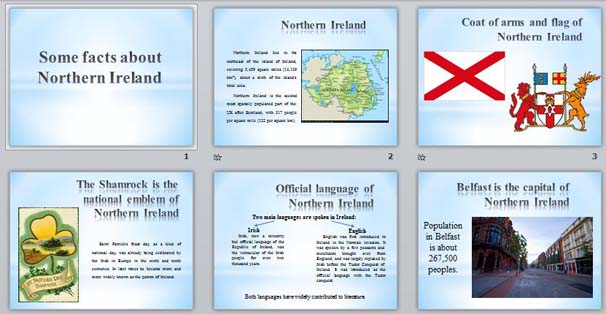
Some facts about Northern Ireland

Northern Ireland
Northern Ireland lies in the northeast of the island of Ireland, covering 5,459 square miles (14,139 km²), about a sixth of the island's total area.
Northern Ireland is the second most sparsely populated part of the UK after Scotland, with 317 people per square mile (122 per square km).

Coat of arms and flag of Northern Ireland

The Shamrock is the national emblem of Northern Ireland
Saint Patrick's feast day, as a kind of national day, was already being celebrated by the Irish in Europe in the ninth and tenth centuries. In later times he became more and more widely known as the patron of Ireland.

Official language of Northern Ireland
Two main languages are spoken in Ireland:
Both languages have widely contributed to literature.
Irish
English
English was first introduced to Ireland in the Norman invasion. It was spoken by a few peasants and merchants brought over from England, and was largely replaced by Irish before the Tudor Conquest of Ireland. It was introduced as the official language with the Tudor conquest.
Irish, now a minority but official language of the Republic of Ireland, was the vernacular of the Irish people for over two thousand years.

Belfast is the capital of Northern Ireland
Population in Belfast is about 267,500 peoples.

Currency
Currency is British Pound Sterling (GBP) .

Economy of Northern Ireland
The Northern Ireland economy is the smallest of the four economies making up the United Kingdom. Northern Ireland has traditionally had an industrial economy, most notably in shipbuilding, rope manufacture and textiles.

Transport of Northern Ireland
Northern Ireland is served by three airports – Belfast International near Antrim, George Best Belfast City integrated into the railway network at Sydenham in East Belfast, and City of Derry in Londonderry.
Major sea ports at Larne and Belfast carry passengers and freight between Great Britain and Northern Ireland. .

Northern Ireland is famous for ...
The Giant's Causeway
The Giant's Causeway, situated on the North East coast of Northern Ireland, is an area of about 40,000 interlocking basalt columns, the result of an ancient volcanic eruption.
Most of the basalt columns are hexagonal in shape.

Wildlife
Ireland has fewer plant and animal species than Britain or mainland Europe. The habitats in Ireland are diverse and include farmland, open woodlands, broadleaf and mixed forests, conifer (evergreen) areas, bogs, and many types of coastal environments.
Red deer
There are only 26 land mammal species that are native to Ireland. Some species, such as the red fox, hedgehog, and badger are very common. Others, such as the Irish hare, red deer and pine marten are seen less often. Wildlife that lives in water, such as turtles, sharks, whales, and dolphins, are common off the coast.

Government
The Northern Ireland Assembly was established as part of the Belfast Agreement (also known as the Good Friday Agreement). The Assembly debates and makes laws, and scrutinises and makes decisions on the work of the Northern Ireland government departments.
Devolution to the Northern Ireland Assembly and Executive was suspended in October 2002 and restored on 8 May 2007.

Thank you!


 Получите свидетельство
Получите свидетельство Вход
Вход

























 Презентация по английскому языку "Some facts about Northern Ireland" (6.62 MB)
Презентация по английскому языку "Some facts about Northern Ireland" (6.62 MB)
 0
0 2064
2064 223
223 Нравится
0
Нравится
0


